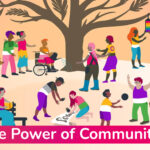Debunk ‘Gender Critical Logic’
1. “Sex is binary and immutable; you can’t change your sex.”
Debunking:
- Scientific consensus supports that biological sex is not strictly binary. Intersex people (~1.7% of the population) are born with variations in sex characteristics that do not fit typical binary notions of male or female.
- Sex comprises chromosomes, hormones, secondary sex characteristics, and genitalia, which don’t always align.
- Medical professionals recognize that gender identity, not chromosomes, is the determinant of how one lives and experiences the world.
2. “Trans women are men and trans men are women.”
Debunking:
- This view misunderstands gender as solely biological, when it is a complex interplay of identity, social roles, and biology.
- Trans people consistently report a strong, persistent gender identity that is incongruent with their sex assigned at birth. This is a medically recognised condition called gender dysphoria.
- International medical organizations (WPATH, AMA, APA) affirm that affirming someone’s gender identity improves mental health and wellbeing.
- Denying a trans person’s identity causes harm and violates principles of basic respect and dignity.
3. “Trans rights erase women’s rights.”
Debunking:
- Trans rights are not a zero-sum game. Expanding rights for one group does not mean removing rights from another.
- Trans women face violence, discrimination, and marginalisation, just like cisgender women do. Feminism should stand against patriarchy, not against other marginalised gender identities.
- Inclusive/intersectional feminism has historically embraced all women, including women of colour, lesbians, and now, trans women.
- Trans inclusion in feminism enriches the movement by tackling gender norms and patriarchal systems more broadly.
4. “Trans people are a threat in women’s single sex spaces (like bathrooms or shelters).”
Debunking:
- There is no evidence that trans people pose a greater risk in gendered spaces. Trans people are more likely to be victims of violence and abuse, not perpetrators.
- Laws and policies that allow trans people to use facilities matching their gender identity do not increase safety risks (as shown in multiple studies in jurisdictions with such laws).
- Denying trans people access to appropriate spaces endangers them, especially trans women who may face assault in male spaces.
5. “Children are being rushed into transition without understanding the consequences.”
Debunking:
- Medical guidelines for youth transition are cautious and evidence-based. Social transition (like name/pronoun use) is safe, reversible, and exploratory.
- Puberty blockers are safe, reversible, and give time for the individual to make informed decisions before the onset of puberty.
- No surgery is done on children, period. Hormones and surgeries are typically considered only in older teens and adults, and only after psychological evaluation.
- Research shows better mental health outcomes when gender-diverse youth are supported and affirmed.
6. “Rapid-onset gender dysphoria (ROGD) proves this is a social contagion.”
Debunking:
- ROGD is not a medically recognised diagnosis. It comes from a single study with flawed methodology (parents self-reporting on forums like 4thWaveNow).
- Peer influence can help youth explore identity, but this is not unique to gender, it happens in fashion and politics, etc.
- Trans people have existed throughout the entirety of history (check out our history timeline) and across all cultures. What’s increasing is visibility, not transness itself.
7. “Trans women have male privilege and therefore shouldn’t be in women’s spaces or sports.”
Debunking:
- While trans women may have experienced male socialisation, they also face significant discrimination as trans people, matching or exceeding the experiences of cis women.
- Many trans women are ostracised, harassed, or assaulted. A reality inconsistent with male privilege.
- Privilege is context-dependent; a trans woman might experience less privilege in every domain due to being trans.
- In sports, trans participation is regulated by hormone levels and physical criteria; there’s no evidence of unfair domination by trans athletes.
8. “Trans identities reinforce sexist stereotypes (e.g., associating femininity with being a woman).”
Debunking:
- Most trans people don’t transition to “fit stereotypes,” but to feel aligned with their internal identity.
- Gender nonconforming people exist across the gender spectrum; many trans men are feminine, and many trans women are masculine.
- Transitioning is about authenticity, not imitation.
- If anything, trans people challenge rigid gender roles by showing that identity isn’t dictated by external expectations.
9. “Allowing self-ID makes women vulnerable.”
Debunking:
- Self-ID policies simply remove unnecessary bureaucratic barriers to recognition, not safeguarding.
- Criminals who want to harm others don’t need to pretend to be trans to access victims. There is no data showing that self-ID leads to an increase in attacks. Self-Id has been legal in the Republic of Ireland since 2015, with no issues.
- Everyday life runs on self-ID. We trust people’s stated religion, race, or even nationality without invasive checking.
10. “You’re erasing the concept of womanhood.”
Debunking:
- No one is erasing womanhood. Trans women are women in their own right, and cis women retain their own experiences. Both are women, cis and trans.
- Womanhood is not owned by biology; it’s an identity shaped by lived experiences, community, and social roles.
- Diverse expressions of womanhood strengthen womanhood, not dilute it.
11. “Desisters prove that transition is a mistake.”
Debunking:
- Desistance mainly refers to socially transitioned prepubescent kids, not teens or adults who medically transition.
- The vast majority of people who transition do not regret it (regret rates for surgery are <1%–2%).
- Informed consent, psychological support, and follow-up care help reduce any risks of detransitioning.
- Those who detransition deserve support, but their experiences don’t invalidate the majority who benefit from transition.
12. “You’re silencing women by calling them transphobic.”
Debunking:
- Criticising harmful views is not silencing, it’s accountability.
- Everyone has freedom of speech, but not freedom from social consequences or criticism, and definitely not freedom from hate speech.
- True feminism includes intersectionality, supporting all women, including trans women and gender-diverse people.
13. “Gender ideology is dangerous and pseudoscientific.”
Debunking:
- “Gender ideology” is a strawman term; gender identity is supported by decades of psychological and medical research.
- The term is used to delegitimise trans people’s existence, not to debate ideas in good faith.
- Respecting people’s identities is not ideology, it’s basic human decency.
14. “Feminism is about biological women; trans women aren’t part of the struggle.”
Debunking:
- Trans women experience patriarchy, sexism, and misogyny, and often more intensely than cis women.
- Feminism’s roots include solidarity with all oppressed genders. Black, lesbian, and trans feminists have historically expanded feminism’s boundaries.
- Reducing feminism to biology undermines its power as a liberatory movement.
15. “You can’t be nonbinary—there are only two sexes.”
Debunking:
- Many cultures recognize third genders (e.g., hijra in South Asia, two-spirit in Indigenous cultures, fa’afafine in Samoa).
- Nonbinary identities have historic and global precedent.
- Nonbinary people experience real psychological distress when misgendered or forced into binaries.
- Recognition improves mental health and social functioning.
16. ” There are only two genders”
Debunking
- The idea that gender is a spectrum recognises that gender identity and expression exist on a continuum, rather than being confined to a binary of male and female
- This means there are many ways individuals can experience and express their gender, and not all people fit neatly into traditional gender categories.
Key Principles to Keep in Mind
- Human dignity is not up for debate.
- Science supports trans identities, and leading organizations (WPATH, AMA, APA, NHS, WHO) support gender-affirming care.
- Debunking TERF ideology involves compassionate communication, but also clear rejection of pseudoscience and bigotry.











